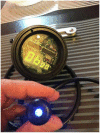Assessment of Alertness and Cognitive Performance of Closed Circuit Rebreather Divers With the Critical Flicker Fusion Frequency Test in Arctic Diving Conditions
- PMID: 34447319
- PMCID: PMC8384076
- DOI: 10.3389/fphys.2021.722915
Assessment of Alertness and Cognitive Performance of Closed Circuit Rebreather Divers With the Critical Flicker Fusion Frequency Test in Arctic Diving Conditions
Abstract
Introduction: Cold water imposes many risks to the diver. These risks include decompression illness, physical and cognitive impairment, and hypothermia. Cognitive impairment can be estimated using a critical flicker fusion frequency (CFFF) test, but this method has only been used in a few studies conducted in an open water environment. We studied the effect of the cold and a helium-containing mixed breathing gas on the cognition of closed circuit rebreather (CCR) divers. Materials and Methods: Twenty-three divers performed an identical dive with controlled trimix gas with a CCR device in an ice-covered quarry. They assessed their thermal comfort at four time points during the dive. In addition, their skin temperature was measured at 5-min intervals throughout the dive. The divers performed the CFFF test before the dive, at target depth, and after the dive. Results: A statistically significant increase of 111.7% in CFFF values was recorded during the dive compared to the pre-dive values (p < 0.0001). The values returned to the baseline after surfacing. There was a significant drop in the divers' skin temperature of 0.48°C every 10 min during the dive (p < 0.001). The divers' subjectively assessed thermal comfort also decreased during the dive (p = 0.01). Conclusion: Our findings showed that neither extreme cold water nor helium-containing mixed breathing gas had any influence on the general CFFF profile described in the previous studies from warmer water and where divers used other breathing gases. We hypothesize that cold-water diving and helium-containing breathing gases do not in these diving conditions cause clinically relevant cerebral impairment. Therefore, we conclude that CCR diving in these conditions is safe from the perspective of alertness and cognitive performance.
Keywords: arctic diving; inert gas narcosis; mixed gas diving; technical diving; thermal control.
Copyright © 2021 Piispanen, Lundell, Tuominen and Räisänen-Sokolowski.
Conflict of interest statement
The authors declare that the research was conducted in the absence of any commercial or financial relationships that could be construed as a potential conflict of interest.
Figures




Similar articles
-
Assessing Critical Flicker Fusion Frequency: Which Confounders? A Narrative Review.Medicina (Kaunas). 2023 Apr 20;59(4):800. doi: 10.3390/medicina59040800. Medicina (Kaunas). 2023. PMID: 37109758 Free PMC article. Review.
-
The effect of a single closed-circuit rebreather decompression dive in extremely cold water to cardiac function.Eur J Appl Physiol. 2024 Jun;124(6):1693-1702. doi: 10.1007/s00421-023-05392-0. Epub 2024 Jan 8. Eur J Appl Physiol. 2024. PMID: 38189825 Free PMC article.
-
Hyperbaric Physics.2024 Jan 31. In: StatPearls [Internet]. Treasure Island (FL): StatPearls Publishing; 2025 Jan–. 2024 Jan 31. In: StatPearls [Internet]. Treasure Island (FL): StatPearls Publishing; 2025 Jan–. PMID: 28846268 Free Books & Documents.
-
Inert gas narcosis in scuba diving, different gases different reactions.Eur J Appl Physiol. 2019 Jan;119(1):247-255. doi: 10.1007/s00421-018-4020-y. Epub 2018 Oct 22. Eur J Appl Physiol. 2019. PMID: 30350155
-
Recreational technical diving part 1: an introduction to technical diving methods and activities.Diving Hyperb Med. 2013 Jun;43(2):86-93. Diving Hyperb Med. 2013. PMID: 23813462 Review.
Cited by
-
Alertness assessment by optical stimulation-induced brainwave entrainment through machine learning classification.Biomed Eng Online. 2025 Aug 12;24(1):100. doi: 10.1186/s12938-025-01422-4. Biomed Eng Online. 2025. PMID: 40797265 Free PMC article.
-
Assessing Critical Flicker Fusion Frequency: Which Confounders? A Narrative Review.Medicina (Kaunas). 2023 Apr 20;59(4):800. doi: 10.3390/medicina59040800. Medicina (Kaunas). 2023. PMID: 37109758 Free PMC article. Review.
-
An Arduino-Powered Device for the Study of White Perception beyond the Visual Chromatic Critical Flicker Fusion Frequency.J Imaging. 2024 Jul 10;10(7):163. doi: 10.3390/jimaging10070163. J Imaging. 2024. PMID: 39057734 Free PMC article.
-
The effect of a single closed-circuit rebreather decompression dive in extremely cold water to cardiac function.Eur J Appl Physiol. 2024 Jun;124(6):1693-1702. doi: 10.1007/s00421-023-05392-0. Epub 2024 Jan 8. Eur J Appl Physiol. 2024. PMID: 38189825 Free PMC article.
-
Neuropsychological and Neurophysiological Mechanisms behind Flickering Light Stimulus Processing.Biology (Basel). 2022 Nov 28;11(12):1720. doi: 10.3390/biology11121720. Biology (Basel). 2022. PMID: 36552230 Free PMC article. Review.
References
-
- Balestra C., Machado M. L., Theunissen S., Balestra A., Cialoni D., Clot C., et al. (2018). Critical flicker fusion frequency: a marker of cerebral arousal during modified gravitational conditions related to parabolic flights. Front. Physiol. 9:1403. 10.3389/fphys.2018.01403, PMID: - DOI - PMC - PubMed
-
- Bennett P. B., Rostain J. C. (2015). “Inert gas narcosis,” in Bennett and Elliott’s Physiology and Medicine of Diving. eds. Brubakk A., Neuman T. S. 5th Edn. (London: Saunders; ), 300–322.
LinkOut - more resources
Full Text Sources

